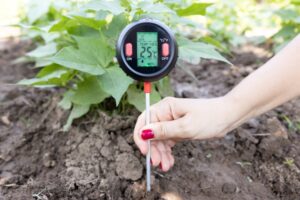Soil testing provides vital information about the availability of soil nutrients. It is also increasingly used to identify the soil layer’s biological and physical characteristics to give an entire picture of overall soil health. Farmers and landowners can use the soil testing data to optimize nutrient management plans. Implementing the recommendations based on the soil test data prevents the under- or over-application of lime and fertilizers. Now that you have understood the role soil testing plays in agriculture, it’s time to learn how to choose a reliable digital soil tester in the USA.
Factors to Consider in Selecting a Solution:
1. Consistency:
Consistency in sample collection and analysis is critical to tracking soil fertility or health changes. Using the same soil testing laboratory, methodology, and technologies enables you to compare the figures from one sampling period to the next to monitor the progress. It is also critical to use consistent sampling methods (soil depth, time of year, etc.).
2. Cost:
Soil testing packages are competitively priced. Although pricing is essential, using cost alone as the selection criteria is misguided. A quality lab or technology does not cut corners, ensures that qualified personnels provide data, and all answers your questions. Most providers offer discounts based on sample or acre/hectare volume.
3. Standard Soil Test Package:
Soil testing providers offer generally a “standard” soil testing package that usually includes pH, cation exchange capacity (CEC), and the availability of nutrients like P, K, Ca, and Mg. Some providers may also include the total organic matter and micronutrients in their “standard” package. Be aware of what kind of tests is included in the standard package when comparing the costs between different labs. A cost comparison should compare the total cost for all the tests you require for your operation.
3. Quality Control Measures:
The soil analysis provider should constantly evaluate its quality by charting the results of its soil sample checks over time. This allows for measuring and assessing the variation over time. Warning and action limits should then be established to assist in the recognition of any unacceptable results if a problem with the soil test should arise. Ideally, the quality control charts need to be used for each of the test parameter. A prospective client should ask to review these quality control charts with the provider prior to selecting a solution.
4. Staff Expertise:
Any lab can generate numbers in a soil test result, but if you need help interpreting what the reported numbers mean, it’s important to work with experienced agronomists or technicians to help provide the context and walk you through your soil test report.

5. Solution Proficiency:
A technology solution’s proficiency refers to its ability to produce accurate test results. It is difficult for a testing laboratory to independently assess this factor. Continued self-evaluation and adjustment improve the integrity of the soil analysis results. At a minimum, companies should conduct internal self-evaluation measures like standard checks or internal reviews.
6. Fertilizer and Lime Recommendations:
Soil test reports can come with the right fertilizer and lime recommendations, but laboratories are not obligated to use university-specific recommendations. Here are a few questions you should ask about recommendations. First, what is the basis of their recommendations? Second, will they be able to provide vetted university recommendations if required upon request?
7. Data Management System:
Many soil analysis service providers have convenient websites where you can log into your account to generate the sample submission forms, review results immediately when available, and even view results from past years. If web access is unavailable, ask if test results are available in digital formats compatible with the agricultural software.
8. Ask Around:
Discuss with county educators, other farmers, and crop consultants about the labs they use. The additional time and effort spent in selecting a quality soil-testing laboratory that will pay off. Do not assume the company delivers quality test results or has a responsive customer service. Save yourself the trouble by finding out for sure.
9. Turnaround Time:
Most solution providers return results within a few days of receiving your soil. If getting data back quickly is essential, ask about typical or guaranteed turnaround times.
10. Additional Services:
While some soil testing solutions focus solely on testing, others offer further tests that may be more useful for your operation. For example, a plant-tissue analysis can be used with soil testing to isolate the fertility problems in the field. Besides, farms using manure, compost, soilless mixes, nutrient solutions, or irrigation water should assess these inputs for their impact on nutrient management.
If you are looking for help in choosing the right soil testing service, get in touch today and learn how high resolution soil mapping could be a fit within your farming operation! Visit https://soiloptix.com/.
